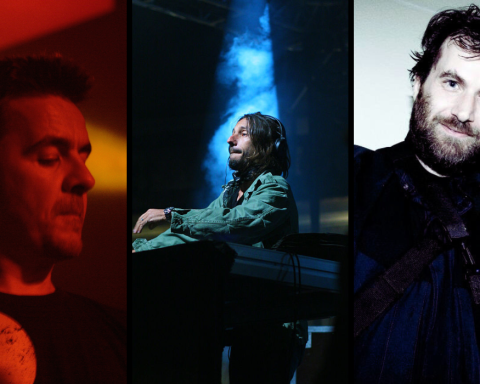In the late ’80s and early ’90s, as club culture was starting to find its footing as a global phenomenon, Jazzie B established himself as a standout producer via his sound system, Soul II Soul. Decades later, Jazzie B’s style—merging funk, dance, and hip-hop—has catalyzed massive hits and served as sample gold for artists following in his eclectic footsteps. Here, we explore a selection of music from his legacy, including bona fide classics and brand-new collaborations.
Playlist
Back To Life by Soul II Soul (1989)
Soul II Soul’s platinum #1 hit defines Jazzie B’s production innovation. The iconic hook began with an a cappella of Soul II Soul mainstay Caron Wheeler. From there, Jazzie B added numerous layers. First was the hallmark boom-bap beat that blended breakbeats with the TR-808 and TR-909. Next, he brought in strings from the Reggae Philharmonic Orchestra. Finally, with the song fleshed out, Wheeler had space to write a complete set of lyrics.
The singer’s career included stints as a backup vocalist for Elvis Costello and Phil Collins, so she knew how to bolster a melody. However, Wheeler was equally well-versed in soul, and “Back To Life” was one of her first lead vocal appearances. She took the opportunity to let her riffs run wild. Her vocals appear in sample form on tracks by Black Eyed Peas, Vybz Kartel, and Burna Boy.
Keep On Movin’ by Soul II Soul (1989)
The other major hit from the Soul II Soul discography was written entirely by Jazzie B. Primed for their residency at the London cultural establishment, Africa Centre, this song is over six minutes long. “Keep On Movin'” gives the dancefloor ample time to set into a relaxed groove while the airtight club beat pushes with the right amount of built-in swing. The song’s extended length allows Wheeler to flex her chops again, and the vocalist pours emotion into the lyrics, responding to the hook with bright riffs.
Fairplay by Soul II Soul (1989)
Soul II Soul’s first single begins with a confident, “Mm-hmm,” signaling the band knew its own power. The track was originally a dubplate, intended only for performances. Yet unlike most sound systems, Jazzie B wanted Soul II Soul to move beyond the club. So, it was a natural choice to begin its recorded legacy with a fan favorite.
One of the lyrics from lead singer Rose Windross harkens back to the group’s residency at Africa Centre: “Soul II Soul is the place where you should be/On Sunday nights with Hector, Chue, and Jazzie B.”
As the track progresses, Windross sets the template for the powerhouse Soul II Soul vocal sound, as an effortlessly minimal drumbeat lays a foundation. The bassline then takes a sonic journey, doubling down on the band’s groovy ambitions.
How We Roll with Cymande (2025)
At the top of 2025, when legendary UK soul/funk outfit, Cymande, released their first album in over five decades, Jazzie B earned a spot as a collaborator on “How We Roll.” The lead singer on the song is Ray Simpson, formerly of Soul II Soul, so the connection to Jazzie B was already in place. The track moves through numerous moods as different instruments have moments to shine alongside Simpson’s crisp vocals. Jazzie B comes to the forefront with an inspiring rap sermon, delivered in his confident, smoky accent.
Get A Life by Soul II Soul (1990)
By the time Soul II Soul was ready to make its second album, Volume II 1990 A New Decade (1990), the group had the respect of global hip-hop fans. It had already emphasized toasting—the historic Caribbean vocal style and precursor to rapping—on songs like “Dance.” N.W.A. even performed with Soul II Soul at the Africa Centre one epic Sunday night in 1988.
So, to kick off promotion for its new record, the group led with a full-fledged rap track: “Get A Life.” String samples begin the track in the same fashion as “Gangsta’s Paradise.” Then, a bouncing beat enters to gracefully propel Jazzie B’s raps. Still, Soul II Soul’s classic vocal riffs remain at the forefront, as Marcia Lewis delivers soulful runs over the chorus.
A Dream’s A Dream by Soul II Soul (1990)
The second single from Soul II Soul’s second album was another significant step forward for its sound. The opening moments blend two genres that ostensibly could not be more different. One is house music, as Jazzie B layers a crisp four-on-the-floor beat with some decorative production. The other is opera. Victoria Wilson-James delivers the hook with a grand quality that would be an excellent fit for the concert hall. The rest of the band arrives with full backing vocals and a funky drum pattern. The exploratory approach was a compelling soundscape for listeners, creating a palette that saw this song chart in 15 countries.
Papa Was a Rollin’ Stone by Soul II Soul with Isaac Hayes (1995)
In 1995, Soul II Soul appeared on the long-running French music television program, Taratata, alongside the master of soul, Isaac Hayes. Rather than perform a song from their original catalogs, the collaboration covered “Papa Was a Rollin’ Stone,” originally by the Motown act the Undisputed Truth, but popularized by the Temptations.
Evoking Soul II Soul’s extended club sets, the whole band (horns, keys, bass, guitar, percussion, drums, and backing vocals) jams to set the mood before Hayes enters with his signature booming tone. Throughout the rest of the rendition, Jazzie B, Charlotte Kelly, and Hayes trade verses between instrumental breaks from the band. The effect is a collective of musicians stretching our rather than a band backing a singer.
Camdino Soul by Soul II Soul (1997)
Whenever a band uses the word “change” in an album title, the music is bound to differ from what came before. Such was the case for Soul II Soul’s 1997 album, Time for Change. With opener, “Camdino Soul,” Jazzie B ushered in a new era for his sound system. Up to that point, the group’s take on club music was slow, groovy, and swung gently. This song accelerates the breakbeat, still featuring adept rhythms and diverse sounds, but now sitting in rave tempo territory. Another sharp left turn is the complete lack of lyrics. The only mid-to-high range sounds are smooth pads and subtle, bubbly melodic lines.







